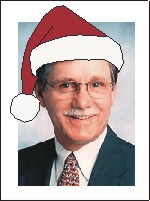For those of you who have noticed my absence from the blogosphere, my excuse is that I have been hip-deep in economics papers. Today I emerge to share a few insights about economists as a group (definitely not referring to any particular economist who happens to be my professor at this time, Dr. Dimitri, and is a wonderful person!).
Economists like to write very long papers, perhaps in the hope that readers will not stick it out through the middle part. The papers begin with broad, visionary statements about how markets function in theory. Then comes a lengthy, dense, mathematical presentation of how this theory would look in mathematical form. Rather than state the obvious in English, there are equations with Greek letters, many tiny subscripts, “dummy” variables, and terms that stand for “everything else that may be important, but which I have no idea about” (called “error” terms).
Then, for readers still standing after the theory section, comes a discussion of why none of the afore-mentioned variables will be used in the actual analysis because such data do not exist. (At this point, one hears screams or cries of anguish.) The conclusions section returns to the visionary statements introduced at the beginning, thus reassuring the reader that the intervening jungle has not lessened the certainty of the economist in the least.
Other observations: In order to be published, all economics papers MUST include the following terms:
- ceteris paribus: this is a problem since I have no idea what ceteris paribus means! (My high school stopped offering Latin the year I arrived.) Based on context, I have decided that it means "assuming away all realistic ideas of how the world works"
- endogeneity: something in the “real world” that intrudes on the tidy world of theoretical modelers and causes distress by violating the modeler’s assumptions that it can be specified and held constant
- internalizing the externalities: I translate this to mean “taking account of all of those things which are not being taken into account” (??!)
- marginal social cost: the cost to the rest of us when businesses are forced to “internalize the externalities” rather than take it out of their profits
[
Disclaimer: this is just me having fun. If you want the REAL definition of these, and other, economic terms, check out this
Glossary of Economic Terms.] The clear implication here is that I need to take more economics classes.
Energy update: Thanks to
Bob Tresley, my windows and doors are weather-stripped, MOST windows are actually closed, and my programmable Honeywell thermostat is installed and functioning. I’m enjoying coming down in the morning to find that the room temperature has already risen to a comfortable level. One other electricity saver was installing power strips around the house so that clusters of electronic gizmos (TVs, computers, VCRs, PlayStations) could be turned off over night. However, this latter is not automated and there are serious implementation glitches. (Note to Honeywell: develop programmable husband.)
 This week Santa’s Elves voted to organize and form a union, reacting in part to concerns that “The Boss in Red” might decide to outsource toy production. In the words of one elf, “If that happens, the jobs go south!” The small workers researched possible unions to affiliate with, but in the end decided on the UAW. “We make cars and trucks, as well as trains and dolls, so it seemed like a good fit” said an elderly elf. Rumor has it that the other deciding factor was that Ron Gettelfinger is just so darn good looking!
This week Santa’s Elves voted to organize and form a union, reacting in part to concerns that “The Boss in Red” might decide to outsource toy production. In the words of one elf, “If that happens, the jobs go south!” The small workers researched possible unions to affiliate with, but in the end decided on the UAW. “We make cars and trucks, as well as trains and dolls, so it seemed like a good fit” said an elderly elf. Rumor has it that the other deciding factor was that Ron Gettelfinger is just so darn good looking! 